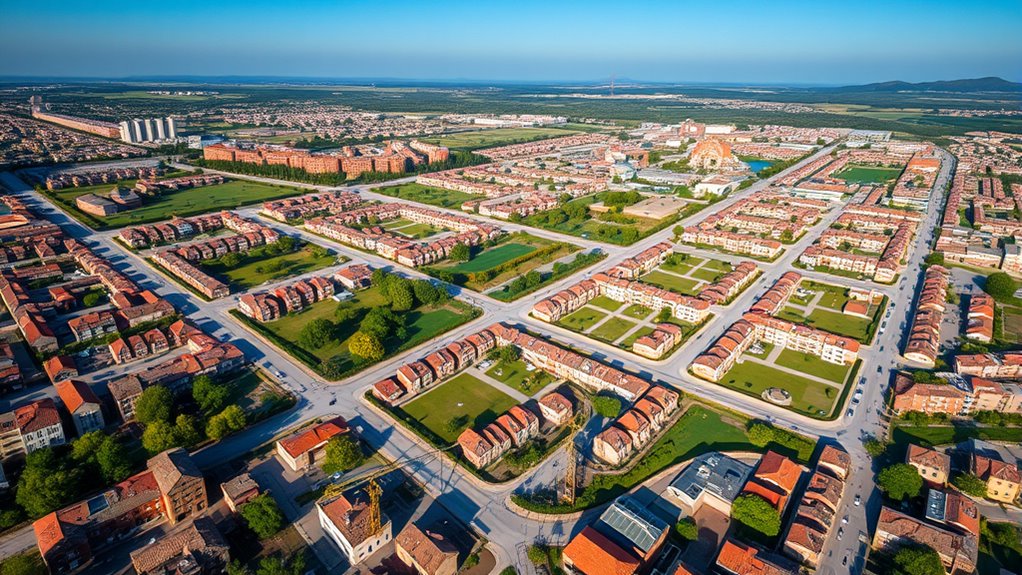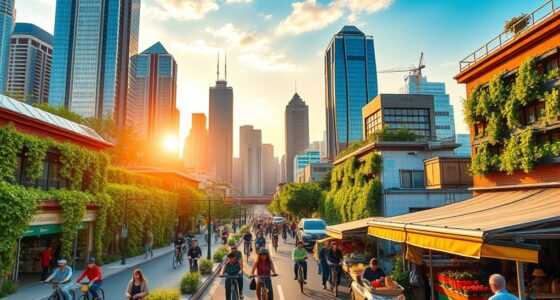Ittiri’s urban development plans focus on protecting its rich cultural heritage, natural landscapes, and wetlands while promoting sustainable growth. You’ll find strategies that preserve historic buildings, safeguard coastal and archaeological assets, and promote eco-friendly infrastructure improvements. The plans also aim to enhance connectivity with new roads, pedestrian bridges, and better transport options. These efforts create a resilient, vibrant community that balances tradition and progress—stay tuned to discover how they plan to achieve this balance in detail.
Key Takeaways
- Ittiri’s urban plans prioritize heritage conservation, including historic buildings, archaeological sites, and cultural assets, through strict regulations and community involvement.
- The city emphasizes landscape and environmental preservation, safeguarding natural landscapes like lakes and wetlands, and promoting sustainable growth strategies.
- Infrastructure projects focus on enhancing connectivity with expanded road networks, pedestrian zones, and eco-friendly public transportation options.
- Coastal and heritage asset protection strategies aim to balance development with environmental and cultural preservation, ensuring vibrant, sustainable tourism.
- Urban development incorporates ecological management of wetlands and biodiversity hotspots, integrating ecosystem services into regional planning efforts.
Regional Landscape Planning and Sustainable Growth Strategies

Regional Landscape Planning plays a crucial role in guiding sustainable growth in Sardinia by establishing upstream control and coordination that go beyond traditional zoning. You’ll find the Regional Landscape Plan (RLP) prioritizes preserving environmental and cultural values, directing tourism toward urban centers instead of unregulated coastal expansion. It identifies landscape components, like historic building surroundings, requiring special restoration guidelines to protect architectural identity. The plan promotes interventions such as selective demolition or reconstruction to remove buildings lacking historic value or harming heritage. It also emphasizes connecting different landscape areas through relational territorial systems, creating an integrated spatial management approach. This strategy guarantees development respects Sardinia’s unique landscape, balancing growth with conservation efforts, and establishing a foundation for sustainable urban expansion aligned with ecological and cultural preservation. Additionally, the plan leverages territorial systems to enhance the connectivity and resilience of landscape areas, fostering a cohesive approach to regional development.
Protecting Coastal and Urban Heritage Assets
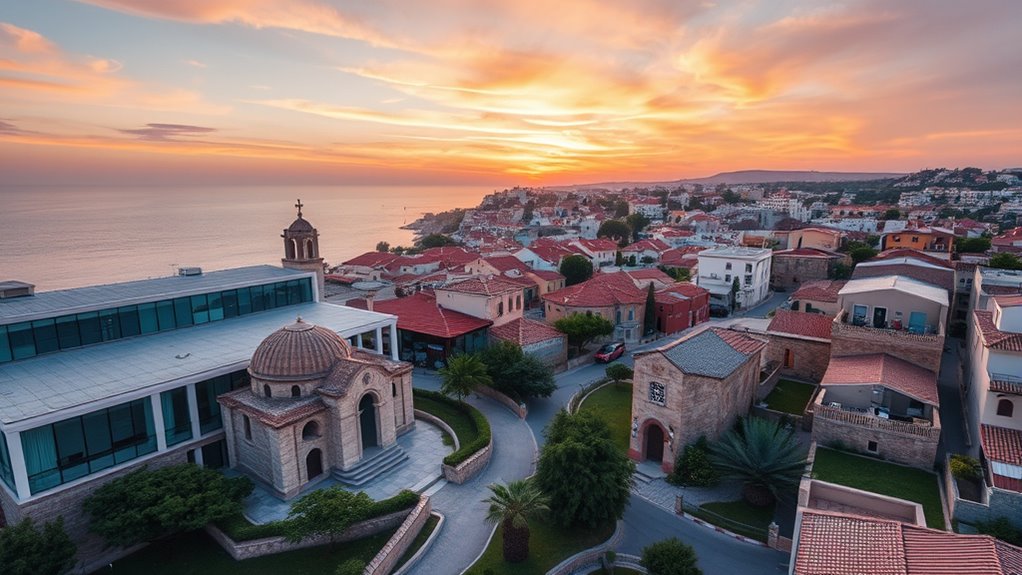
You need to focus on implementing coastal preservation strategies that balance development with environmental protection. Enforcing historic building regulations helps maintain Ittiri’s architectural identity, while safeguarding cultural assets guarantees the town’s heritage remains vibrant. The town’s location on a high plain at 450 meters above sea level supports the importance of protecting its natural landscape and archaeological sites. Additionally, fostering creative practice in urban planning encourages innovative solutions for sustainable development. Together, these efforts support sustainable growth that honors both the past and the natural landscape.
Coastal Preservation Strategies
Protecting coastal and urban heritage assets requires a holistic approach that balances environmental conservation with community needs. You should prioritize adaptive management systems that use intelligent water controls and environmental sensors to monitor water quality, pH, and oxygen levels, helping maintain ecosystem health in Corru S’Ittiri-Marceddì-San Giovanni. Reforestation of lagoon banks supports this effort, strengthening wetland resilience through nature-based solutions involving local communities. Addressing policy gaps is essential; stalled initiatives like the Maristanis Park hinder coordinated protection, risking pollution, industrial agriculture, and energy projects that threaten ecological integrity. Valuing ecosystem services highlights the economic importance of wetlands, underscoring the need for urgent action. Implementing innovative habitat projects, like artificial islets for bird nesting, further preserves biodiversity and supports sustainable coastal development. Additionally, climate change poses increasing risks to coastal areas, emphasizing the urgency of integrating climate adaptation measures into urban development plans. Moreover, understanding Juice Packaging and Storage best practices can aid in reducing environmental waste associated with packaging materials.
Historic Building Regulations
In Ittiri, safeguarding historic buildings relies on a thorough legal framework that enforces strict preservation standards. Sardinian regional laws protect architectural heritage, requiring approval from heritage authorities before any renovation. These rules emphasize maintaining original materials and construction methods, like using traditional trachyte stone for repairs. Urban plans incorporate heritage preservation as a core criterion within zoning regulations. Regulations mandate preserving original façades, especially on Liberty, Baroque, or neoclassical buildings, and restrict modern additions to be reversible and distinguishable. Projects involving historic structures must submit detailed documentation, including plans and heritage impact assessments, for evaluation by a conservation commission. Use restrictions limit buildings to cultural, religious, or administrative functions, while maintenance routines prioritize traditional craftsmanship to prevent deterioration. The preservation of architectural integrity is often supported by specific legal protections and incentives. Penalties deter unauthorized alterations or demolitions, ensuring long-term protection of Ittiri’s heritage assets.
Cultural Asset Conservation
How does Ittiri make certain its coastal and urban heritage assets remain vibrant and resilient for future generations? It prioritizes protecting natural landscapes like lakes Bidighinzu, Cuga, and Temo, ensuring their visual harmony with surrounding peaks and valleys. Conservation efforts focus on safeguarding archaeological sites such as Neolithic necropolises and Nuragic remains, employing structural protections and careful access controls. The medieval Church of Santa Maria di Coros and other religious sites receive ongoing preservation to maintain their Romanesque and Gothic features, with restoration of masonry and artifacts. Additionally, Ittiri emphasizes preserving intangible cultural heritage—traditional crafts, folk practices, and rural traditions—integrating them into its conservation strategies. The church’s architectural features, like its ogival barrel-vaulted roof, serve as tangible links to Sardinia’s medieval religious history and help foster community pride. Community engagement, educational programs, and sustainable tourism ensure these assets remain essential and appreciated for generations to come. To further enhance conservation, Ittiri also promotes heritage awareness among residents and visitors, encouraging active participation in preservation efforts.
Environmental Conservation and Wetland Management
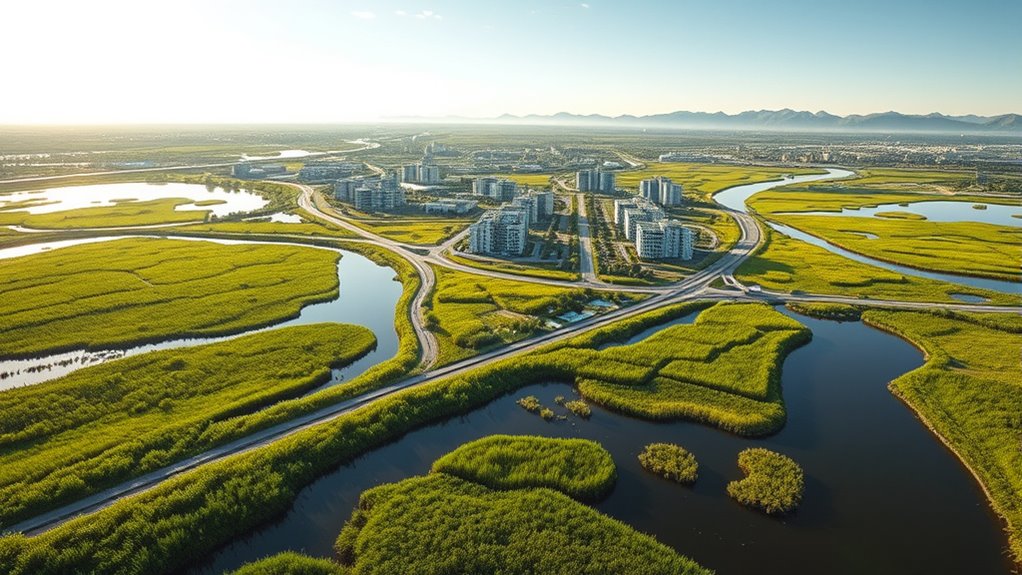
Have you ever considered the crucial role wetlands play in maintaining ecological balance and supporting local economies? The Maristanis wetlands in Ittiri span about 7,700 hectares, including ponds and lagoons recognized under the Ramsar Convention, highlighting their global importance. These wetlands are indispensable biodiversity hotspots, hosting endangered species and critical habitats that need focused protection. They offer essential ecosystem services, with potential economic benefits estimated at EUR 306 million over 40 years, especially if their quality is preserved. Effective management has been challenging due to fragmented governance, but new integrated models are being developed to coordinate efforts among regional authorities, local municipalities, and conservation groups. Restoration initiatives focus on water management, pollution control, and habitat rehab, boosting productivity and climate resilience while supporting local livelihoods. Wetlands also serve as natural water filters, improving water quality and supporting sustainable development in the region. Recognizing the ecological importance of wetlands is vital for ensuring their long-term conservation and integration into regional development plans.
Enhancing Urban Connectivity and Infrastructure Development

You’ll see efforts to improve transport links by expanding road networks and developing intermodal hubs. Pedestrian-friendly zones will make walking safer and more enjoyable for everyone. These initiatives aim to boost connectivity and create a more accessible, efficient urban environment. Additionally, substantial funding has been allocated to support these projects, ensuring their successful implementation and sustainability.
Improving Transport Links
Ittiri’s urban development plans focus on strengthening transport links to boost connectivity and support economic growth. You’ll see upgrades to main roads connecting Ittiri to Oristano and Sassari, reducing travel times and easing congestion. New bypasses will divert traffic away from the town center, improving flow during peak hours. Smart traffic management systems will optimize signals, reducing emissions and delays. Rural roads will be enhanced to better access agricultural zones and neighborhoods. Public transportation will expand with more bus routes linking Ittiri to Sardinian hubs like Cagliari and Olbia, with increased frequency and eco-friendly vehicles. Additionally, regional rail connectivity is under study to improve station facilities and increase train frequency. These improvements will make your commute smoother, safer, and more sustainable. Ecosystem services from wetlands can contribute to sustainable urban development. Moreover, understanding regional transportation infrastructure strategies can help residents and planners optimize future growth.
Promoting Pedestrian Connectivity
To enhance urban connectivity, Ittiri is integrating pedestrian and cycle bridges that effectively link separated areas and improve non-motorized travel options. For example, a 120-meter cycle and pedestrian bridge connects municipalities divided by natural barriers, boosting pedestrian flow. These bridges also provide access to new public spaces created from repurposed infrastructure, like former railway yards. Their designs vary from 3 to 5.5 meters wide, accommodating cyclists and walkers alike. Strategically placed within protected natural and archaeological environments, they support sustainable development without disrupting sensitive areas. Additionally, these bridges are key components of longer route networks, such as the Pelagos Cycle Route, which spans roughly 12 km, linking urban centers and encouraging active transportation. This infrastructure makes walking and cycling safer, more convenient, and more appealing for residents and visitors. Incorporating color accuracy considerations in the planning process ensures that visual elements in these projects are both functional and aesthetically pleasing.
Preserving Cultural Identity and Architectural Coherence

Preserving Ittiri’s cultural identity and architectural coherence remains central to its urban development efforts. You’re encouraged to respect traditional styles and local materials, guaranteeing visual continuity with historic structures. Zoning policies restrict incompatible modern interventions, maintaining the town’s unique character. Development proposals are carefully reviewed by regional authorities specializing in archaeology and landscape to safeguard heritage. Infrastructure upgrades like walkways and public spaces are designed to blend seamlessly with existing aesthetics. Environmental features like wetlands are integrated into the urban fabric, reinforcing cultural links to the landscape. The table below highlights key preservation strategies:
| Strategy | Focus | Outcome |
|---|---|---|
| Cultural Heritage Conservation | Protect historic fishing villages and customs | Strengthens community identity |
| Architectural Coherence | Maintain traditional building styles | Ensures visual harmony |
| Environmental Integration | Embed wetlands and natural features | Preserves ecological and cultural links |
Additionally, incorporating local materials in new constructions helps reinforce the area’s traditional aesthetic.
Economic and Social Impacts of Integrated Urban Planning
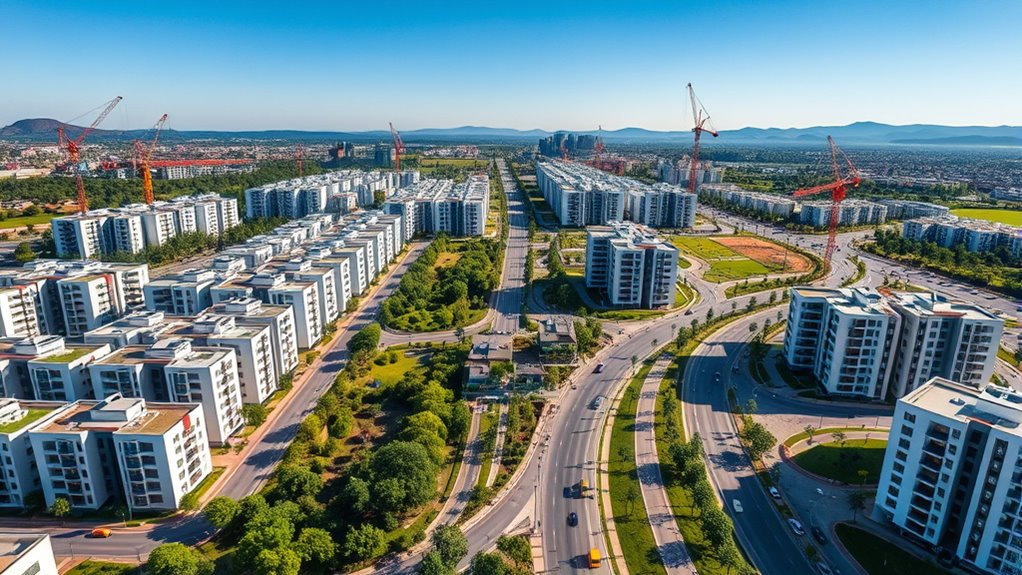
Integrated urban planning drives significant economic and social benefits by fostering sustainable growth and community well-being. You’ll notice job creation as planning connects residents to sustainable employment opportunities, boosting economic stability. Efficient resource use maximizes tax revenues, stimulating various sectors. Cities benefit from GDP growth, serving as hubs of activity that fuel broader economic development. Additionally, innovation flourishes in well-designed environments, increasing productivity and knowledge exchange. Socially, integrated planning promotes equitable service distribution, ensuring everyone has access to essential amenities. It encourages inclusive decision-making, involving diverse community voices. Plans also help create resilient, sustainable neighborhoods, improving health and education outcomes. Population management balances growth across urban and peripheral areas, supporting long-term social cohesion. Furthermore, integrated planning enhances community resilience by preparing cities to better respond to environmental and social challenges, including those highlighted in local urban development initiatives.
Frequently Asked Questions
How Will New Urban Plans Affect Local Residents’ Daily Lives?
You’ll notice changes in your daily life as new urban plans bring more green spaces, renovated housing, and improved infrastructure. These upgrades make your neighborhood more walkable and energy-efficient, helping you save on utilities. New businesses and cultural events boost local activity, offering more shopping and entertainment options. However, rising rents and property values could make it harder to stay if you’re a renter or long-term resident, so stay informed and involved.
What Specific Regulations Protect Historic Buildings in Ittiri?
Like a shield guarding treasures, specific regulations protect Ittiri’s historic buildings. You must get approval from regional heritage authorities before altering any protected structure. These rules ensure preservation of architectural styles, like baroque and liberty designs, that define Ittiri’s character. Strict conservation laws cover religious sites, archaeological finds, and historic façades, requiring detailed permits and expert oversight. This way, you help maintain Ittiri’s rich history alive for future generations.
Are There Plans for Eco-Friendly Transportation Options in Ittiri?
You’re asking about eco-friendly transportation options in Ittiri. Regional plans aim to boost sustainable mobility across Sardinia, including expanding rail and bus networks, introducing electric and hydrogen buses, and creating cycle routes. Near Ittiri, new cycle paths are being developed to connect urban and touristic areas, promoting bike travel. These initiatives help reduce emissions, support eco-tourism, and foster a culture of sustainable travel in your community.
How Does Wetland Preservation Impact Future Urban Expansion?
Wetland preservation greatly influences future urban expansion by guiding sustainable development. You need to ensure protecting these vital ecosystems to maintain biodiversity, control climate effects, and support local economies through tourism and agriculture. By balancing growth with conservation, you can prevent pollution and habitat loss. Implementing innovative land use and engaging the community ensures urban plans align with environmental goals, creating a resilient, sustainable future that benefits both development and wetland health.
What Funding Sources Support Ittiri’S Sustainable Urban Development Projects?
Imagine stepping into a future where your town thrives sustainably—funding makes that happen. You’re supported by the European Regional Development Fund, allocating millions for urban projects, and the Sardegna Region’s JESSICA initiative, focusing on energy efficiency and urban growth. Additionally, the EIB offers loans for renewable projects, while regional funds boost local revitalization. These sources empower you to shape a greener, more resilient Ittiri for generations to come.
Conclusion
By embracing ittiri’s extensive urban development plans, you can help create a sustainable, vibrant city that respects its heritage and environment. With thoughtful strategies in place, you’ll foster better connectivity, preserve cultural identity, and boost economic growth. Isn’t shaping a future where tradition meets progress worth aiming for? Together, you can make ittiri not just a place to live, but a community that thrives for generations to come.
